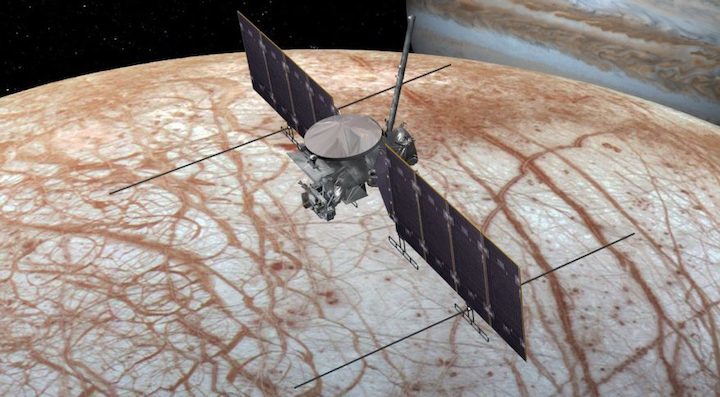5.02.2020

SANTA CLARA, Calif. — The management of NASA’s Europa Clipper mission, facing dwindling cost reserves while still years away from launch, is looking at cost saving options that would preserve the mission’s science.
In a Feb. 3 presentation at a meeting of the Outer Planets Assessment Group in Houston, Jan Chodas, project manager for Europa Clipper at the Jet Propulsion Laboratory, said she was looking for ways to restore cost reserves that had declined precipitously in the last year.
Chodas said that Europa Clipper had met a JPL recommendation of 25% cost reserves, known at the lab as unallocated future expenses (UFE), when it completed a final “delta” preliminary design review in June 2019. By November, though, those reserves had fallen to just 12%, a level deemed “unacceptably low” for a mission not scheduled for launch until at least 2023.
That decline, she said, was due in part due to instruments and flight subsystems that “experienced both development challenges and schedules slips, which is not unusual at all.” Those issues nonetheless drained the reserves far more than anticipated.
The mission is now working to restore those cost reserves through some cost-saving measures. “We polled the team for ideas, and we implemented some scope reductions on the engineering side,” she said. That includes streamlining hardware testing and scaling back work on flight spare hardware. The project has also reduced the frequency of meetings of the mission’s science team.
“All of these were done from the perspective of low risk,” she said, meaning that the changes are not intended to increase the risk to the overall mission. “We really needed to take a fine-tooth comb through all of our activities and see what we can descope from a low-risk perspective.”
The goal is to restore those reserves to 20% by the time the project completes its critical design review, currently scheduled for August, which would comply with JPL guidelines. “I don’t know yet how close we’ll be to that target. We have made progress since hitting the low of 12% back in November, but it’s still a work in progress,” Chodas said.
A project status meeting is scheduled for early March with Thomas Zurbuchen, NASA associate administrator for science. One purpose of the meeting is to provide “a holistic evaluation of our UFE situation,” she said. That could include discussing recommendations for “science descopes, if needed, in order to manage within the project’s financial resources.”
Chodas emphasized that such changes to the mission would be a last resort. “We’re fully committed to flying this incredible payload to Europa and make all of these amazing science discoveries,” she said.
NASA, however, has already revised the instrument payload for the mission because of cost problems. In March 2019, Zurbuchen announced that he was removing a magnetometer instrument called ICEMAG from Europa Clipper because of increasing costs and potential for future increases. NASA will instead fly a simpler, but less capable, magnetometer on the spacecraft.
Europa Clipper passed a major milestone called Key Decision Point C in August 2019. At that milestone, the agency set a baseline cost of $4.25 billion for the mission, covering all phases of development and operations.
NASA has yet to finalize a launch date and vehicle for the mission. Congress has directed NASA on several occasions to use the Space Launch System rocket, which would allow the spacecraft to get to Jupiter directly without the need for gravity assist flybys. The fiscal year 2020 appropriations bill, enacted in December, again directed the use of SLS, but pushed back the launch date to no later than 2025, two years later than previous plans.
NASA has sought to use a commercial launch vehicle for launching Europa Clipper, saying that while the vehicle’s performance would not be as great as SLS and thus require flybys, extending the transit time to Jupiter by several years, it would save hundreds of millions of dollars and free up the SLS for the Artemis program of human lunar exploration.
A provision in a NASA authorization bill introduced in the House Jan. 24 would allow NASA to make the final decision on a launch vehicle for Europa Clipper after carrying out an assessment that considers the various cost and schedule issues associated with using SLS and alternative vehicles. The study would also have to examine if an increased SLS production rate, sought in another section of the bill, could free up the vehicle for use launching Europa Clipper.
Quelle: SN
